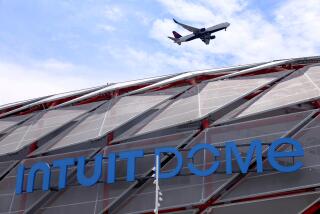Legislator Pushes Bill to Make Training Manadatory : Bartenders Learn to Fight Drunk Driving
- Share via
BURLINGAME, Calif. — The man taking Curtis Christy’s drink order at the Amfac Hotel here Monday turned out to be state Sen. Nicholas Petris, which pleased Christy.
“I’ve always wanted to be served by a senator,” he said. “After all, you are a public servant.”
There was more to Christy’s pleasure than that, however, for he had pressed Petris into service to demonstrate some of the techniques that Christy was teaching the hotel’s servers in an effort to control their customers’ drinking. Role playing is a key part of the “servers’ intervention program”--SIP--sponsored by San Mateo County under a two-year federal grant.
Petris, a Democrat from Oakland, has introduced legislation to make such training mandatory for all who sell or serve alcoholic beverages, from servers to retail clerks.
“I’m not declaring war on alcoholic beverages,” Petris said later at a news conference. But, he added, the Legislature, which has strengthened penalties for driving under the influence, has yet to emphasize prevention.
“We spend enormous amounts of money to fix the thing after it’s broken,” said Petris, whose bill will face its first committee test April 1. “Voluntary programs simply don’t work because they don’t reach enough people and lack uniformity,” he said.
That point was underlined by Christy, a private consultant who conducted two days of training--Friday and Monday--for Amfac bartenders and servers under the county’s Project SMASH (for San Mateans Advocating Sober Highways). He said only one in eight of the county’s 800 liquor license holders responded to an offer for similar free training.
“Servers are the main link in the chain of prevention,” Christy told the hotel’s staff. He showed them how, by observation and discreet questioning, to assess a customer’s condition, capacity, attitude and intentions on entering, then how to monitor the customer’s drinking to keep him from becoming what Petris called “an unguided missile” while driving home.
The goal, Christy said, is to keep the customer’s blood alcohol level lower than the legal limit--0.10%--for motorists.
“If you wait for signs of intoxication, you’re too late,” he explained. “You’ve got to count drinks, tell people to slow down or cut them off.”
This can be done politely and should include offering such options as switching to non-alcoholic beverages or food or merely slowing down the rate of drinking, he said.
Establishments providing alcoholic beverages have been found liable for damages--including traffic fatalities--caused by motorists whom they had served, he noted. As a result, liquor liability insurance has become increasingly scarce and costly.
“If risk exposure can be cut through server training,” he said, “it makes sense to encourage it.”
Legislation introduced in the Assembly would establish a legal defense in liquor liability lawsuits if bars meet specified criteria, including proper sobriety training, said Victor J. Colman, a legal research analyst with the Trauma Foundation at San Francisco General Hospital, who shared teaching chores with Christy.
San Mateo County, on the San Francisco Peninsula midway between San Jose and San Francisco, has played a leading role in curbing drunk drivers through Project SMASH. The program is financed by a $310,000 grant from the National Highway Traffic Safety Administration.
The first “sobriety checkpoints” conducted by the California Highway Patrol were set up in Burlingame with the project’s support, Christy said. Although only one in eight of the county’s liquor-dispensing businesses responded to Project SMASH’s inquiry about training their staffs, he said, the response nonetheless shows a growing awareness of the importance of training to doing business here.
“Customers are worried about going out to drink and getting stopped on the way home,” he told the class. “They want to go somewhere where the management takes care of them.”
More to Read
Get the L.A. Times Politics newsletter
Deeply reported insights into legislation, politics and policy from Sacramento, Washington and beyond. In your inbox twice per week.
You may occasionally receive promotional content from the Los Angeles Times.










